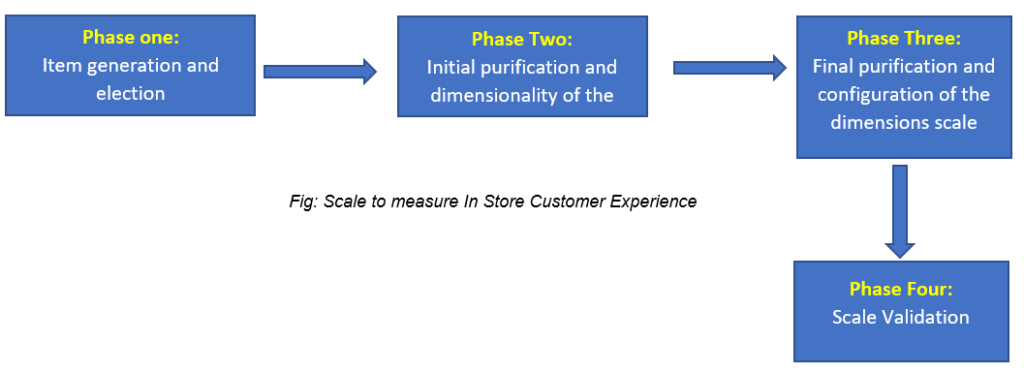This article presents a summary of research paper Measuring customer experience in physical retail environments. The summary was written during a master’s degree course as an assignment. The reference to these papers are provided at the end of the article for readers interested in further reading.
Before we dive into the theories, let’s take a closer look at the various components that make up the Customer Experience in a more understandable way.
Cognitive Experience
When we talk about cognitive experience, we’re referring to how our brains process information. It involves the ability to perceive, acquire knowledge, and use our subjective characteristics to understand and interact with the world around us. However, cognitive experience is not limited to just acquiring knowledge or engaging in logical thinking. It goes beyond that and encompasses how customers creatively engage with brands and stores in response to stimuli present in their environment. It’s about how they classify, analyze, reason, and make meaning out of their interactions.
Affective Experience
The affective system is the part of our experience that is linked to our emotions and moods. Emotions are intense feelings that are associated with specific objects or situations. They can be positive or negative and have a significant impact on how customers perceive their overall experience. On the other hand, moods are more general and less intense states of feeling. In the context of Customer Experience, it is more relevant to focus on emotions rather than moods. Emotions are more closely tied to specific triggers and can vary in intensity, influencing how customers engage with brands and stores.
The Physical Component
The physical component of Customer Experience refers to the physiological responses that customers experience during their interactions with the environment. It involves how our bodies respond and react to the stimuli around us. For example, it can manifest as a state of well-being, comfort, or discomfort. Physical experience is deeply connected to our senses and how we perceive and engage with the physical aspects of a brand or store. It could be the ambiance, the layout, the temperature, the lighting, or any other physical attribute that affects our well-being and comfort levels.
Understanding these different components is crucial in comprehending the theories that we will explore later on. Each of these elements contributes to how customers perceive, engage with, and form impressions of brands and their surroundings, ultimately shaping their overall experience. By considering the cognitive, affective, and physical aspects of the Customer Experience, businesses can gain insights into how to enhance and improve their interactions with customers to create memorable and satisfying experiences.
Some highlights from research papers
- Marketing experts agree that Customer Experience (CEx) plays a vital role in creating a competitive advantage for businesses over time.
- CEx is considered a cornerstone of marketing and has a strong theoretical foundation to develop a deeper understanding of the concept.
- One perspective on CEx, known as the stimulus perspective, focuses on the external stimuli provided by the service provider that influence a customer’s perception of their experience.
- While researchers often discuss the internal and contextual aspects of CEX, there is a need for a more in-depth analysis of the internal processes. Additionally, there is a demand for practical tools to improve managerial practices across various service contexts.
- Adopting a phenomenological or sense-based perspective, CEx in the service context is defined as having both internal and contextual components.
- Experiences are triggered by specific stimuli and are not self-generated but induced. They are states that arise in the presence of a stimulus rather than evaluations or affective states within an individual.
- Memorable experiences involve personal relevance, novelty, surprise, learning, and engagement for the customer. Connecting with customers and making them feel immersed and actively participating in the experience contributes to memorability.
- The sensory component of CEx is closely linked to the physical well-being individuals experience in a specific environment. Responses to sensory stimuli such as lighting, colours, music, scent, and more have an impact on the physical well-being and comfort/discomfort of individuals.
- Despite the theoretical development of CEx, there has been limited attention given to measuring CEx in service research.
- Two approaches to measuring CEx include the Experience Quality Scale, which assesses evaluative judgments about the service based on four dimensions, and the use of Structural Equation Models (SEMs) to measure CEx through cognitions, feelings, sensations, and behavioural and sensory responses.
Based on these theoretical concepts, the experience in a retail environment is the result of the interaction between the customer and the experience provider. It’s a collaborative process where both parties contribute to creating the experience. Customer Experience can occur in various ways within the retail setting.
- Firstly, CEx can happen when customers interact with the products themselves, known as the “experience with the product.” For example, when you test out a piece of furniture or try on clothes, you’re engaging in a product-focused experience.
- Secondly, CEx can also occur when customers engage with the physical environment of the retailer, including the store layout, the staff, and the store policies and practices. This is referred to as the “shopping experience.” For instance, when a store has well-organized displays, helpful staff, and a pleasant atmosphere, it enhances the overall shopping experience.
- Lastly, CEx extends to the consumption and use of the product itself. This is known as the “consumption experience.” It encompasses the satisfaction and enjoyment that customers derive from using the purchased product.
Measuring Customer Experience
When it comes to measuring CEx in service research, there are two main approaches. The first approach involves measuring CEx based on customers’ perceptions or evaluative judgments of the different components that contribute to the overall service experience. Researchers and practitioners have developed scales, like the ISCX scale, to assess and analyze the stimuli that influence CEx and its various components.

For example, let’s take a look at Ikea. They create small model spaces within their stores, showcasing living room, bedroom, and kitchen ideas. These setups activate customers’ thoughts and make their shopping experience easier. Ikea also provides informative labels for these displays, indicating the complete references of the products and their location in the warehouse. So, if a customer like a particular combination, they can easily find and purchase the corresponding products from the warehouse. This illustrates how a retailer like Ikea strategically designs their store environment to enhance the overall customer experience.
Summary:
This blog post explores the components of Customer Experience (CEx) in an understandable way. It covers cognitive experience (how our brains process information), affective experience (emotions and moods), and the physical component (physiological responses). Understanding these elements is crucial for businesses to enhance customer interactions. The article also highlights research insights, different approaches to measuring CEx, and the importance of CEx in retail settings. A practical example from Ikea illustrates strategic store design. Overall, the post emphasizes the need to optimize cognitive, affective, and physical aspects to create memorable and satisfying customer experiences.
Reference:
Bustamante, J.C., N. Rubio (2017). Measuring the customer experience in physical retail environments. Journal of Service Management, 28(5), 884-913.
Also, read Digital Marketing for banks




